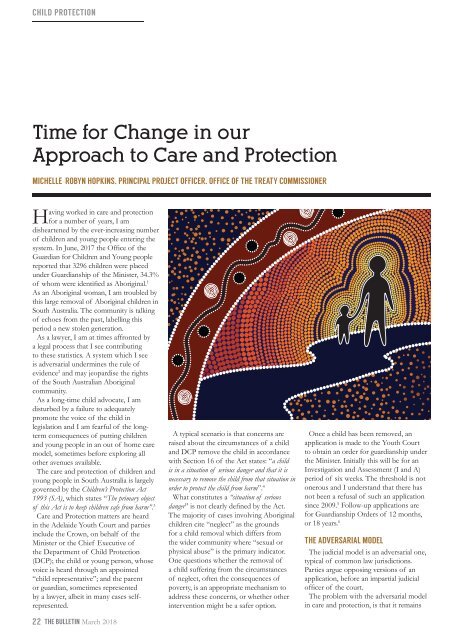LSB March 2018_Web
You also want an ePaper? Increase the reach of your titles
YUMPU automatically turns print PDFs into web optimized ePapers that Google loves.
CHILD PROTECTION<br />
Time for Change in our<br />
Approach to Care and P rotection<br />
MICHELLE-ROBYN HOPKINS, PRINCIPAL PROJECT OFFICER, OFFICE OF THE TREATY COMMISSIONER<br />
Having worked in care and protection<br />
for a number of years, I am<br />
disheartened by the ever-increasing number<br />
of children and young people entering the<br />
system. In June, 2017 the Office of the<br />
Guardian for Children and Young people<br />
reported that 3296 children were placed<br />
under Guardianship of the Minister, 34.3%<br />
of whom were identified as Aboriginal. 1<br />
As an Aboriginal woman, I am troubled by<br />
this large removal of Aboriginal children in<br />
South Australia. The community is talking<br />
of echoes from the past, labelling this<br />
period a new stolen generation.<br />
As a lawyer, I am at times affronted by<br />
a legal process that I see contributing<br />
to these statistics. A system which I see<br />
is adversarial undermines the rule of<br />
evidence 2 and may jeopardise the rights<br />
of the South Australian Aboriginal<br />
community.<br />
As a long-time child advocate, I am<br />
disturbed by a failure to adequately<br />
promote the voice of the child in<br />
legislation and I am fearful of the longterm<br />
consequences of putting children<br />
and young people in an out of home care<br />
model, sometimes before exploring all<br />
other avenues available.<br />
The care and protection of children and<br />
young people in South Australia is largely<br />
governed by the Children’s Protection Act<br />
1993 (SA), which states “The primary object<br />
of this Act is to keep children safe from harm”. 3<br />
Care and Protection matters are heard<br />
in the Adelaide Youth Court and parties<br />
include the Crown, on behalf of the<br />
Minister or the Chief Executive of<br />
the Department of Child Protection<br />
(DCP); the child or young person, whose<br />
voice is heard through an appointed<br />
“child representative”; and the parent<br />
or guardian, sometimes represented<br />
by a lawyer, albeit in many cases selfrepresented.<br />
22 THE BULLETIN <strong>March</strong> <strong>2018</strong><br />
A typical scenario is that concerns are<br />
raised about the circumstances of a child<br />
and DCP remove the child in accordance<br />
with Section 16 of the Act states: “a child<br />
is in a situation of serious danger and that it is<br />
necessary to remove the child from that situation in<br />
order to protect the child from harm”. 4<br />
What constitutes a “situation of serious<br />
danger” is not clearly defined by the Act.<br />
The majority of cases involving Aboriginal<br />
children cite “neglect” as the grounds<br />
for a child removal which differs from<br />
the wider community where “sexual or<br />
physical abuse” is the primary indicator.<br />
One questions whether the removal of<br />
a child suffering from the circumstances<br />
of neglect, often the consequences of<br />
poverty, is an appropriate mechanism to<br />
address these concerns, or whether other<br />
intervention might be a safer option.<br />
Once a child has been removed, an<br />
application is made to the Youth Court<br />
to obtain an order for guardianship under<br />
the Minister. Initially this will be for an<br />
Investigation and Assessment (I and A)<br />
period of six weeks. The threshold is not<br />
onerous and I understand that there has<br />
not been a refusal of such an application<br />
since 2009. 5 Follow-up applications are<br />
for Guardianship Orders of 12 months,<br />
or 18 years. 6<br />
THE ADVERSARIAL MODEL<br />
The judicial model is an adversarial one,<br />
typical of common law jurisdictions.<br />
Parties argue opposing versions of an<br />
application, before an impartial judicial<br />
officer of the court.<br />
The problem with the adversarial model<br />
in care and protection, is that it remains


















